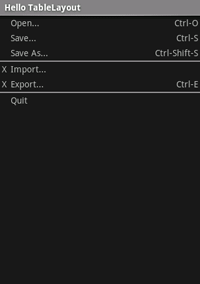Remarque
L’accès à cette page nécessite une autorisation. Vous pouvez essayer de vous connecter ou de modifier des répertoires.
L’accès à cette page nécessite une autorisation. Vous pouvez essayer de modifier des répertoires.
TableLayout est unViewGroup qui affiche l’enfantView éléments dans des lignes et des colonnes.
Démarrez un nouveau projet nommé HelloTableLayout.
Ouvrez le fichier Resources/Layout/content_main.xml et insérez les éléments suivants :
<?xml version="1.0" encoding="utf-8"?>
<TableLayout xmlns:android="http://schemas.android.com/apk/res/android"
android:layout_width="fill_parent"
android:layout_height="fill_parent"
android:stretchColumns="1">
<TableRow
android:layout_width="match_parent"
android:layout_height="match_parent">
<TextView
android:layout_width="wrap_content"
android:layout_height="wrap_content"
android:layout_column="1"
android:text="Open..."
android:padding="3dip"/>
<TextView
android:layout_width="wrap_content"
android:layout_height="wrap_content"
android:text="Ctrl-O"
android:gravity="right"
android:padding="3dip"/>
</TableRow>
<TableRow
android:layout_width="match_parent"
android:layout_height="match_parent">
<TextView
android:layout_width="wrap_content"
android:layout_height="wrap_content"
android:layout_column="1"
android:text="Save..."
android:padding="3dip"/>
<TextView
android:layout_width="wrap_content"
android:layout_height="wrap_content"
android:text="Ctrl-S"
android:gravity="right"
android:padding="3dip"/>
</TableRow>
<TableRow
android:layout_width="match_parent"
android:layout_height="match_parent">
<TextView
android:layout_width="wrap_content"
android:layout_height="wrap_content"
android:layout_column="1"
android:text="Save As..."
android:padding="3dip"/>
<TextView
android:layout_width="wrap_content"
android:layout_height="wrap_content"
android:text="Ctrl-Shift-S"
android:gravity="right"
android:padding="3dip"/>
</TableRow>
<View
android:layout_width="wrap_content"
android:layout_height="2dip"
android:background="#FF909090"/>
<TableRow
android:layout_width="match_parent"
android:layout_height="match_parent">
<TextView
android:layout_width="wrap_content"
android:layout_height="wrap_content"
android:text="X"
android:padding="3dip"/>
<TextView
android:layout_width="wrap_content"
android:layout_height="wrap_content"
android:text="Import..."
android:padding="3dip"/>
</TableRow>
<TableRow
android:layout_width="match_parent"
android:layout_height="match_parent">
<TextView
android:layout_width="wrap_content"
android:layout_height="wrap_content"
android:text="X"
android:padding="3dip"/>
<TextView
android:layout_width="wrap_content"
android:layout_height="wrap_content"
android:text="Export..."
android:padding="3dip"/>
<TextView
android:layout_width="wrap_content"
android:layout_height="wrap_content"
android:text="Ctrl-E"
android:gravity="right"
android:padding="3dip"/>
</TableRow>
<View
android:layout_width="wrap_content"
android:layout_height="2dip"
android:background="#FF909090"/>
<TableRow
android:layout_width="match_parent"
android:layout_height="match_parent">
<TextView
android:layout_width="wrap_content"
android:layout_height="wrap_content"
android:layout_column="1"
android:text="Quit"
android:padding="3dip"/>
</TableRow>
</TableLayout>
Notez à quel point cela ressemble à la structure d’une table HTML. TheTableLayout l’élément est semblable à l’élément HTML <table> ;TableRow est comme un <tr> élément ; mais pour les cellules, vous pouvez utiliser n’importe quel type d’élément View . Dans cet exemple, unTextView est utilisé pour chaque cellule. Entre certaines lignes, il existe également un élément de base View, qui est utilisé pour dessiner une ligne horizontale.
Assurez-vous que votre activité HelloTableLayout charge cette disposition dans leMéthode OnCreate() :
protected override void OnCreate (Bundle savedInstanceState)
{
base.OnCreate (savedInstanceState);
SetContentView (Resource.Layout.Main);
}
La SetContentView(int)méthode ) charge le fichier de disposition pour , Activityspécifié par l’ID de ressource — Resource.Layout.Main fait référence au fichier de disposition Resources/Layout/Main.axml .
Exécutez l’application. Les éléments suivants doivent s’afficher :
Références
Les parties de cette page sont des modifications basées sur le travail créé et partagé par le projet Open Source Android et utilisés selon les termes décrits dans la licence d’attribution Creative Commons 2.5.
